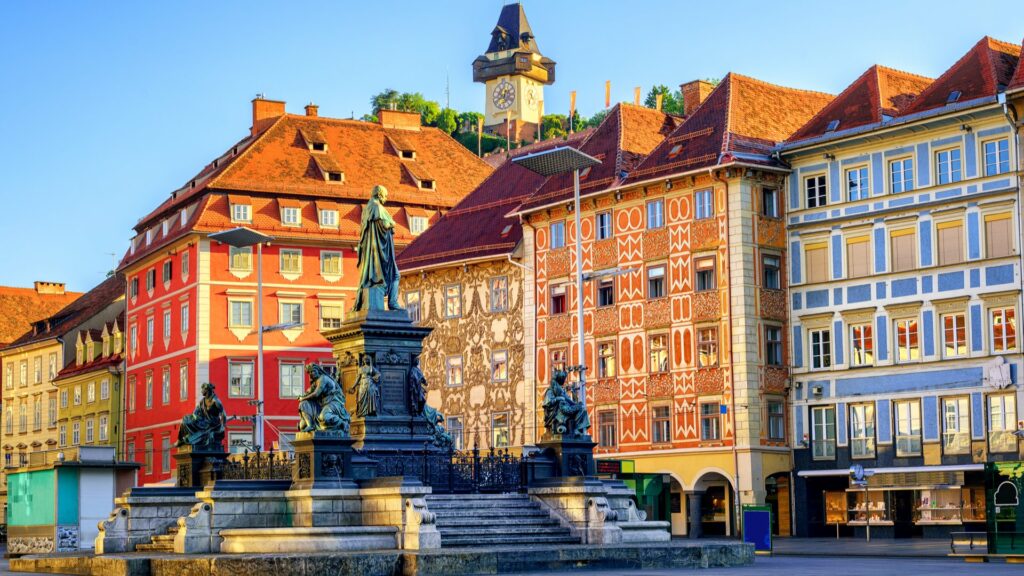Graz, Austria: A Tapestry of Renaissance Elegance, Modern Innovation, and Culinary Delights

Introduction:
Nestled in the heart of Styria, Graz, Austria, emerges as a city that effortlessly marries its Renaissance roots with contemporary vibrancy. Renowned for its well-preserved historic architecture, a flourishing arts scene, and a rich culinary tradition, Graz stands as a cultural hub that captivates visitors with its unique charm. In this comprehensive exploration, we embark on a journey through the diverse layers of Graz, unraveling its historical treasures, innovative spirit, and the gastronomic delights that make it a gem in the Austrian landscape.
I. Historic Tapestry:
A. Schlossberg: Graz’s skyline is dominated by the Schlossberg, a historic castle hill that boasts a fortress with roots dating back to the 10th century. The Clock Tower, a prominent landmark, offers panoramic views of the city, while the lush greenery and walking trails create a serene escape within the urban landscape.
B. Old Town (Altstadt): Graz’s Old Town, a UNESCO World Heritage Site, is a labyrinth of narrow medieval streets, charming squares, and well-preserved Renaissance buildings. The Hauptplatz (Main Square) stands as the beating heart of the Old Town, surrounded by architectural gems like the Rathaus (City Hall) and the Landhaus.
II. Architectural Marvels:
A. Graz Cathedral: The Graz Cathedral, also known as St. Giles’ Cathedral, stands as a masterpiece of Gothic architecture. The cathedral’s intricate details and stunning stained glass windows provide a glimpse into Graz’s religious and artistic heritage.
B. Kunsthaus Graz: In stark contrast to its historic surroundings, Kunsthaus Graz, or the Graz Art Museum, is a modern architectural marvel. Designed with biomorphic shapes and a striking blue acrylic façade, the museum showcases contemporary art exhibitions, adding a touch of avant-garde to Graz’s architectural landscape.
III. Cultural Institutions:
A. Universalmuseum Joanneum: Graz is home to the Universalmuseum Joanneum, one of the oldest public museums in Europe. Comprising multiple museums, including the Styrian Armoury and the Alte Galerie, it offers a comprehensive exploration of art, history, and culture.
B. Graz Opera House: The Graz Opera House, a testament to the city’s musical tradition, hosts opera and ballet performances in a grand setting. With its opulent interiors and world-class productions, the opera house contributes to Graz’s cultural richness.
IV. University Town:
A. University of Graz: Graz’s status as a university town is highlighted by the presence of the University of Graz, founded in 1585. The university’s historic campus, with its academic buildings and lively student atmosphere, adds an intellectual vibrancy to the city.
B. Student Culture: Graz’s youthful energy is palpable in its vibrant student culture. Cafés, bars, and cultural events cater to the city’s student population, creating an atmosphere of creativity and dynamism.
V. Culinary Delights:
A. Styrian Cuisine: Graz takes pride in its Styrian culinary heritage, known for its emphasis on fresh, local ingredients. Pumpkin seed oil, Styrian ham, and traditional dishes like Backhendl (fried chicken) are culinary delights that showcase the region’s gastronomic excellence.
B. Farmers’ Markets: Exploring Graz’s farmers’ markets, such as the Lendplatz Markt and the Kaiser-Josef-Platz Markt, is a sensory delight. Fresh produce, artisanal cheeses, and local specialties create a culinary tapestry that reflects the city’s commitment to quality and sustainability.
VI. City of Design:
A. UNESCO City of Design: Graz has earned the title of a UNESCO City of Design, recognizing its commitment to fostering creativity and innovation in design. The city’s vibrant design scene is evident in its architecture, urban planning, and cultural initiatives.
B. Murinsel: An iconic example of Graz’s innovative design is the Murinsel, a floating platform on the Mur River. Designed by artist Vito Acconci, this unique structure serves as an urban island and cultural venue, contributing to Graz’s reputation as a city that embraces contemporary design.
VII. Natural Oases:
A. Stadtpark: Graz’s Stadtpark, a green oasis in the heart of the city, offers a respite from urban hustle. With manicured lawns, walking paths, and art installations, the park provides a tranquil escape for residents and visitors alike.
B. Eggenberg Palace Gardens: Surrounding Eggenberg Palace, the palace gardens boast Baroque elegance with terraced landscapes, fountains, and sculptures. These meticulously landscaped gardens provide a serene setting for leisurely strolls and cultural events.
VIII. Sustainability Initiatives:
A. Graz 2030 – European Capital of Culture: Graz has set its sights on becoming the European Capital of Culture in 2030, emphasizing sustainability and cultural development. This initiative underscores the city’s commitment to long-term planning, environmental consciousness, and inclusive cultural practices.
B. Green Mobility: Graz promotes green mobility through initiatives like cycling infrastructure, electric public transportation, and pedestrian-friendly zones. These efforts contribute to a sustainable urban environment, reducing the ecological footprint of transportation.
IX. Conclusion:
Graz, with its Renaissance charm, innovative spirit, and culinary excellence, invites visitors to discover a city that seamlessly blends history with modernity. Whether exploring the cobblestone streets of the Old Town, indulging in Styrian delicacies, or immersing oneself in the city’s vibrant cultural scene, Graz captivates with its unique character and dynamic atmosphere. In this city of contrasts, where medieval architecture harmonizes with contemporary design, and centuries-old traditions coalesce with forward-thinking initiatives, Graz stands as a cultural gem that leaves a lasting impression on those fortunate enough to experience its diverse tapestry.




